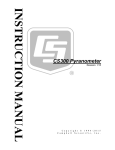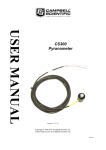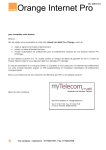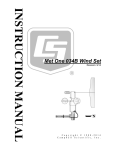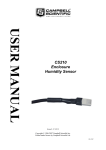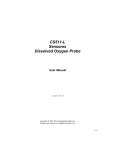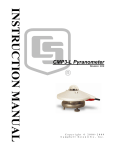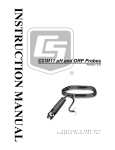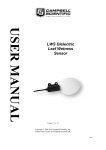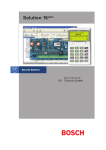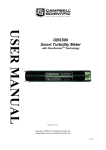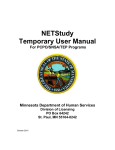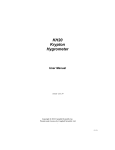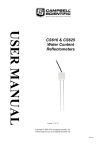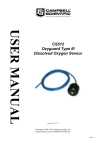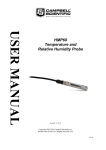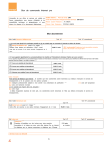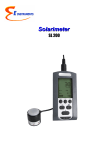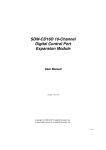Download LP02 Pyranometer - Campbell Scientific
Transcript
USER MANUAL LP02 Pyranometer Issued: 9.9.15 Copyright © 2006-2015 Campbell Scientific, Inc. Printed under licence by Campbell Scientific Ltd. CSL 528 Guarantee This equipment is guaranteed against defects in materials and workmanship. This guarantee applies for 24 months from date of delivery. We will repair or replace products which prove to be defective during the guarantee period provided they are returned to us prepaid. The guarantee will not apply to: Equipment which has been modified or altered in any way without the written permission of Campbell Scientific Batteries Any product which has been subjected to misuse, neglect, acts of God or damage in transit. Campbell Scientific will return guaranteed equipment by surface carrier prepaid. Campbell Scientific will not reimburse the claimant for costs incurred in removing and/or reinstalling equipment. This guarantee and the Company’s obligation thereunder is in lieu of all other guarantees, expressed or implied, including those of suitability and fitness for a particular purpose. Campbell Scientific is not liable for consequential damage. Please inform us before returning equipment and obtain a Repair Reference Number whether the repair is under guarantee or not. Please state the faults as clearly as possible, and if the product is out of the guarantee period it should be accompanied by a purchase order. Quotations for repairs can be given on request. It is the policy of Campbell Scientific to protect the health of its employees and provide a safe working environment, in support of this policy a “Declaration of Hazardous Material and Decontamination” form will be issued for completion. When returning equipment, the Repair Reference Number must be clearly marked on the outside of the package. Complete the “Declaration of Hazardous Material and Decontamination” form and ensure a completed copy is returned with your goods. Please note your Repair may not be processed if you do not include a copy of this form and Campbell Scientific Ltd reserves the right to return goods at the customers’ expense. Note that goods sent air freight are subject to Customs clearance fees which Campbell Scientific will charge to customers. In many cases, these charges are greater than the cost of the repair. Campbell Scientific Ltd, 80 Hathern Road, Shepshed, Loughborough, LE12 9GX, UK Tel: +44 (0) 1509 601141 Fax: +44 (0) 1509 601091 Email: [email protected] www.campbellsci.co.uk PLEASE READ FIRST About this manual Please note that this manual was originally produced by Campbell Scientific Inc. primarily for the North American market. Some spellings, weights and measures may reflect this origin. Some useful conversion factors: Area: 1 in2 (square inch) = 645 mm2 Length: 1 in. (inch) = 25.4 mm 1 ft (foot) = 304.8 mm 1 yard = 0.914 m 1 mile = 1.609 km Mass: 1 oz. (ounce) = 28.35 g 1 lb (pound weight) = 0.454 kg Pressure: 1 psi (lb/in2) = 68.95 mb Volume: 1 UK pint = 568.3 ml 1 UK gallon = 4.546 litres 1 US gallon = 3.785 litres In addition, while most of the information in the manual is correct for all countries, certain information is specific to the North American market and so may not be applicable to European users. Differences include the U.S standard external power supply details where some information (for example the AC transformer input voltage) will not be applicable for British/European use. Please note, however, that when a power supply adapter is ordered it will be suitable for use in your country. Reference to some radio transmitters, digital cell phones and aerials may also not be applicable according to your locality. Some brackets, shields and enclosure options, including wiring, are not sold as standard items in the European market; in some cases alternatives are offered. Details of the alternatives will be covered in separate manuals. Part numbers prefixed with a “#” symbol are special order parts for use with non-EU variants or for special installations. Please quote the full part number with the # when ordering. Recycling information At the end of this product’s life it should not be put in commercial or domestic refuse but sent for recycling. Any batteries contained within the product or used during the products life should be removed from the product and also be sent to an appropriate recycling facility. Campbell Scientific Ltd can advise on the recycling of the equipment and in some cases arrange collection and the correct disposal of it, although charges may apply for some items or territories. For further advice or support, please contact Campbell Scientific Ltd, or your local agent. Campbell Scientific Ltd, Campbell Park, 80 Hathern Road, Shepshed, Loughborough, LE12 9GX, UK Tel: +44 (0) 1509 601141 Fax: +44 (0) 1509 601091 Email: [email protected] www.campbellsci.co.uk Precautions DANGER — MANY HAZARDS ARE ASSOCIATED WITH INSTALLING, USING, MAINTAINING, AND WORKING ON OR AROUND TRIPODS, TOWERS, AND ANY ATTACHMENTS TO TRIPODS AND TOWERS SUCH AS SENSORS, CROSSARMS, ENCLOSURES, ANTENNAS, ETC. FAILURE TO PROPERLY AND COMPLETELY ASSEMBLE, INSTALL, OPERATE, USE, AND MAINTAIN TRIPODS, TOWERS, AND ATTACHMENTS, AND FAILURE TO HEED WARNINGS, INCREASES THE RISK OF DEATH, ACCIDENT, SERIOUS INJURY, PROPERTY DAMAGE, AND PRODUCT FAILURE. TAKE ALL REASONABLE PRECAUTIONS TO AVOID THESE HAZARDS. CHECK WITH YOUR ORGANIZATION'S SAFETY COORDINATOR (OR POLICY) FOR PROCEDURES AND REQUIRED PROTECTIVE EQUIPMENT PRIOR TO PERFORMING ANY WORK. Use tripods, towers, and attachments to tripods and towers only for purposes for which they are designed. Do not exceed design limits. Be familiar and comply with all instructions provided in product manuals. Manuals are available at www.campbellsci.eu or by telephoning +44(0) 1509 828 888 (UK). You are responsible for conformance with governing codes and regulations, including safety regulations, and the integrity and location of structures or land to which towers, tripods, and any attachments are attached. Installation sites should be evaluated and approved by a qualified engineer. If questions or concerns arise regarding installation, use, or maintenance of tripods, towers, attachments, or electrical connections, consult with a licensed and qualified engineer or electrician. General • Prior to performing site or installation work, obtain required approvals and permits. Comply with all governing structure-height regulations, such as those of the FAA in the USA. • Use only qualified personnel for installation, use, and maintenance of tripods and towers, and any attachments to tripods and towers. The use of licensed and qualified contractors is highly recommended. • Read all applicable instructions carefully and understand procedures thoroughly before beginning work. • Wear a hardhat and eye protection, and take other appropriate safety precautions while working on or around tripods and towers. • Do not climb tripods or towers at any time, and prohibit climbing by other persons. Take reasonable precautions to secure tripod and tower sites from trespassers. • Use only manufacturer recommended parts, materials, and tools. Utility and Electrical • You can be killed or sustain serious bodily injury if the tripod, tower, or attachments you are installing, constructing, using, or maintaining, or a tool, stake, or anchor, come in contact with overhead or underground utility lines. • Maintain a distance of at least one-and-one-half times structure height, or 20 feet, or the distance required by applicable law, whichever is greater, between overhead utility lines and the structure (tripod, tower, attachments, or tools). • Prior to performing site or installation work, inform all utility companies and have all underground utilities marked. • Comply with all electrical codes. Electrical equipment and related grounding devices should be installed by a licensed and qualified electrician. Elevated Work and Weather • Exercise extreme caution when performing elevated work. • Use appropriate equipment and safety practices. • During installation and maintenance, keep tower and tripod sites clear of un-trained or non-essential personnel. Take precautions to prevent elevated tools and objects from dropping. • Do not perform any work in inclement weather, including wind, rain, snow, lightning, etc. Maintenance • Periodically (at least yearly) check for wear and damage, including corrosion, stress cracks, frayed cables, loose cable clamps, cable tightness, etc. and take necessary corrective actions. • Periodically (at least yearly) check electrical ground connections. WHILE EVERY ATTEMPT IS MADE TO EMBODY THE HIGHEST DEGREE OF SAFETY IN ALL CAMPBELL SCIENTIFIC PRODUCTS, THE CUSTOMER ASSUMES ALL RISK FROM ANY INJURY RESULTING FROM IMPROPER INSTALLATION, USE, OR MAINTENANCE OF TRIPODS, TOWERS, OR ATTACHMENTS TO TRIPODS AND TOWERS SUCH AS SENSORS, CROSSARMS, ENCLOSURES, ANTENNAS, ETC. Contents PDF viewers: These page numbers refer to the printed version of this document. Use the PDF reader bookmarks tab for links to specific sections. 1. Introduction ................................................................ 1 2. Cautionary Statements .............................................. 1 3. Initial Inspection ........................................................ 1 3.1 3.2 Ships With ............................................................................................ 1 Calibration Certificate .......................................................................... 1 4. Quickstart ................................................................... 2 4.1 4.2 4.3 Siting Considerations ........................................................................... 2 Mounting .............................................................................................. 2 Short Cut Programming ....................................................................... 4 5. Overview ..................................................................... 7 6. Specifications ............................................................ 8 7. Operation .................................................................... 9 7.1 7.2 Wiring .................................................................................................. 9 Programming...................................................................................... 10 7.2.1 Input Range ................................................................................. 11 7.2.2 Multiplier .................................................................................... 11 7.2.3 Offset .......................................................................................... 11 7.2.4 Output Format Considerations .................................................... 12 8. Maintenance ............................................................. 12 9. Troubleshooting ...................................................... 12 Appendices A. Importing Short Cut Code Into a Program Editor .................................................................... A-1 B. Example Programs ................................................ B-1 B.1 CR1000 Example Program .............................................................. B-1 4-1. 4-2. 4-3. 4-4. CM225 bracket attached to a crossarm ................................................ 2 LP02 mounting hole ............................................................................. 3 CM225 bracket mounting holes ........................................................... 3 LP02 Pyranometer attached to CM225 Solar Sensor Mounting Stand ................................................................................................. 4 LP02 Schematic ................................................................................... 9 Figures 7-1. i Tables 7-1. 7-2. 7-3. Differential Connections to Campbell Scientific Dataloggers ............. 9 Single-Ended Connections to Campbell Scientific Dataloggers ........ 10 Multipliers Required for Flux Density and Total Fluxes ................... 11 ii LP02 Pyranometer 1. Introduction The LP02 is an ISO-second-class pyranometer that monitors solar radiation for the full solar spectrum range. It produces a millivolt signal that can be measured directly by a Campbell Scientific datalogger. The LP02 can provide solar radiation measurements for many meteorological applications. This pyranometer is manufactured by Hukseflux. Before using the LP02, please study: Section 2, Cautionary Statements (p.1) Section 3, Initial Inspection (p. 1) Section 4, Quickstart (p. 2) For Edlog datalogger support, check the availability of an older manual at www.campbellsci.com/old-manuals, or contact a Campbell Scientific application engineer for assistance. 2. 3. Cautionary Statements READ AND UNDERSTAND the Precautions section at the front of this manual. Although the LP02 is rugged, it is also a highly precise scientific instrument and should be handled as such. Care should be taken when opening the shipping package to not damage or cut the cable jacket. If damage to the cable is suspected, consult with a Campbell Scientific application engineer. Initial Inspection 3.1 Upon receipt of the LP02, inspect the packaging and contents for damage. File damage claims with the shipping company. The model number and cable length are printed on a label at the connection end of the cable. Check this information against the shipping documents to ensure the correct product and cable length are received. See Section 3.1, Ships With (p. 1), to ensure that all of your parts are included. Ships With (1) Bolt for mounting from original manufacturer (2) Nuts for mounting from original manufacturer (1) Calibration certificate (see Section 3.2, Calibration Certificate (p. 1)) (2) Bolts for mounting from original manufacturer (1) ResourceDVD 3.2 Calibration Certificate Included with the sensor is a calibration certificate with the sensor calibration constant and serial number. Cross check this serial number against the serial number on your LP02 to ensure that the given calibration constant corresponds to your sensor. 1 LP02 Pyranometer 4. Quickstart Please review Section 7, Operation (p. 9), for wiring and CRBasic programming. 4.1 Siting Considerations The LP02 is usually installed horizontally, but can also be installed at any angle including an inverted position. In all cases, it will measure the flux that is incident on the surface that is parallel to the sensor surface. Site the LP02 to allow easy access for maintenance while ideally avoiding any obstructions above the plane of the sensing element. It is important to mount the LP02 such that no shadow or reflection will not be cast on it at any time. If this is not possible, try to choose a site where any obstruction over the azimuth range between earliest sunrise and latest sunset has an elevation not exceeding 5°. Diffuse solar radiation is less influenced by obstructions near the horizon. For instance, an obstruction with an elevation of 5° over the whole azimuth range of 360° decreases the downward diffuse solar radiation by only 0.8%. 4.2 Mounting Below shows the steps for using the CM225 mounting bracket kit to mount the LP02 to a vertical pipe (1.0 to 2.1 in. OD), or to a CM202, CM203, CM204, or CM206 crossarm. If the sensor needs to be mounted at an angle, a CM255 or CM255LS adjustable-angle mount can be used instead (see the CM225, CM255, and CM255LS Solar Mount Application Note). CAUTION The CM225 should never be mounted directly to a vertical pipe. Instead, the CM225 should be mounted to a crossarm. This avoids reflections from the vertical pipe onto the sensor. Attach the CM225 to crossarm (see Figure 4-1). Figure 4-1. CM225 bracket attached to a crossarm 1. 2 Place the LP02 in the centre of the CM225 with the cable pointing to the nearest magnetic pole, and align the sensor’s mounting holes with two of the bracket’s mounting holes (see Figure 4-2 and Figure 4-3). User Manual Mounting Hole Figure 4-2. LP02 mounting hole Mounting Hole Mounting Hole Mounting Hole Figure 4-3. CM225 bracket mounting holes 3 LP02 Pyranometer 2. Place the mounting screws in the mounting holes and slightly tighten them. The levelling screws should lightly touch the mounting plate (see Figure 4-4). LP02 Pyranometer Bubble Level Cable Tie (3) Leveling Screws CM225 Solar Sensor Mounting Stand (2) Mounting Screws CM200 Series Crossarm Figure 4-4. LP02 Pyranometer attached to CM225 Solar Sensor Mounting Stand 4.3 3. Starting with the levelling screw nearest the bubble level, turn the levelling screws to bring the bubble of the bubble level within the ring (see Figure 4-4). 4. Tighten the mounting screws to secure the assembly in its final position. 5. Route the sensor cable to the instrument enclosure. 6. Use cable ties to secure the cable to CM225 bracket and to the vertical pipe or crossarm and tripod/tower (see Figure 4-4). Short Cut Programming Short Cut is an easy way to program your datalogger to measure the pyranometer and assign datalogger wiring terminals. Use the following procedure to get started. 4 1. Install Short Cut by clicking on the install file icon. Get the install file from either www.campbellsci.com, the ResourceDVD, or find it in installations of LoggerNet, PC200W, PC400, or RTDAQ software. 2. The Short Cut installation should place a Short Cut icon on the desktop of your computer. To open Short Cut, click on this icon. User Manual 3. When Short Cut opens, select New Program. 4. Select Datalogger Model and Scan Interval (default of 5 seconds is OK for most applications). Click Next. 5 LP02 Pyranometer 5. Under the Available Sensors and Devices list, select Sensors | Meteorological | Solar Radiation folder. Select LP02 Pyranometer. Click to move the selection to the Selected device window. Enter the Sensitivity supplied on the manufacturer’s certificate of calibration; this calibration factor is unique to each sensor. The public variable defaults can typically be used. After entering the information, click on OK, and then select Next. 6 User Manual 6. After selecting the sensitivity values, click at the left of the screen on Wiring Diagram to see how the sensor is to be wired to the datalogger. The wiring diagram can be printed out now or after more sensors are added. 5. 7. Select any other sensors you have, and then finish the remaining Short Cut steps to complete the program. The remaining steps are outlined in Short Cut Help, which is accessed by clicking on Help | Contents | Programming Steps. 8. If LoggerNet, PC400, RTDAQ, or PC200W is running on your PC, and the PC to datalogger connection is active, you can click Finish in Short Cut and you will be prompted to send the program just created to the datalogger. 9. If the sensor is connected to the datalogger, as shown in the wiring diagram in step 6, check the output of the sensor in the datalogger support software data display to make sure it is making reasonable measurements. Overview The LP02 pyranometer is designed for continuous outdoor use. Due to its flat spectral sensitivity from 280 to 3000 nm, it can be used in natural sunlight, under plant canopies, in green houses or buildings, and inverted to measure reflected solar radiation. Two LP02s can be used in combination to measure albedo. The LP02 can also be used to measure most types of artificial light (Xenon lamps, Halogen lamps, etc.). The LP02 pyranometer consists of a thermopile sensor, housing, dome, and cable. The thermopile is coated with a black absorbent coating. The paint absorbs the radiation and converts it to heat. The resultant temperature difference is converted to a voltage by the copper-constantan thermopile. The thermopile is encapsulated in the housing in such a way that it has a field of view of 180 degrees and the angular characteristics needed to fulfil the cosine response requirements. 7 LP02 Pyranometer 6. Specifications Features: Compatible with the following CRBasic dataloggers: CR6, CR800, CR850, CR1000, CR3000, CR5000, and CR9000(X). Measures reflected solar radiation when inverted Provides measurements in direct sunlight, under plant canopies, when the sky is cloudy, and in artificial light Includes bubble level and levelling screws eliminating need for a separate levelling base, which simplifies installation Compatible with the CWS900-series interfaces, allowing it to be used in a wireless sensor network Acceptable for providing the solar radiation data used in stability estimations Dome protects thermopile and allows water to roll off of it Overall classification according to ISO 9060 / WMO: Second class pyranometer Response time for 95% response: 18 s –2 8 Zero offset (response to 200 W m net thermal radiation): < 15 W m–2 Zero offset (response to 5 K/h change in ambient temperature): < 4 W m–2 Non-stability: < 1% change per year Non-linearity: < ±1% (100 to 1000 W m–2) Directional response for beam radiation: within ±25 W m–2 Spectral selectivity: ±5% (280 to 3000 nm) Temperature response (within an interval of 50°C): ±3% (–10 to 40 °C) Tilt response: within ±2% Sensitivity (nominal): 15 μV (W m–2) Expected voltage output: 0.1 to +50 mV in natural sunlight Operating temperature range: –40 to 80 °C Sensor resistance: Between 40 and 60 Range: 0 to 2000 W m–2 Cable replacement: Cable can be replaced by the user Spectral range: 280 to 3000 nm (50% transmission points) Levelling: Level and levelling feet included Expected accuracy for daily sums: ±10% Dome diameter: 3 cm (1.2 in) Height: 5.9 cm (2.3 in) Body diameter: 7.8 cm (3.1 in) Weight with 15 ft cable: 363 g (0.8 lb) User Manual 1Guide to Meteorological Instruments and Methods of Observation, fifth edition, WMO, Geneva and ISO9060 7. Operation If you are programming your datalogger with Short Cut, skip Section 7.1, Wiring (p. 9), and Section 7.2, Programming (p. 10). Short Cut does this work for you. See Section 4, Quickstart (p. 2), for a Short Cut tutorial. 7.1 Wiring A schematic diagram of the LP02 is shown in Figure 7-1. White Green Clear Figure 7-1. LP02 Schematic When Short Cut is used to create the datalogger program, the sensor should be wired to the channels shown in the wiring diagram created by Short Cut. A differential voltage measurement is recommended because it has better noise rejection than a single-ended measurement. If a differential channel is not available, a single-ended measurement can be used. Connections to Campbell Scientific dataloggers for a differential measurement are given in Table 7-1. A user-supplied jumper wire should be connected between the low side of the differential input and ground (AG or ⏚) to keep the signal in common mode range. Connections to Campbell Scientific dataloggers for a single-ended measurement are given in Table 7-2. Table 7-1. Differential Connections to Campbell Scientific Dataloggers Colour Description CR6, CR9000(X) CR5000, CR3000 CR1000, CR800 CR850 White Signal (+) DIFF Analog High Green Signal (–) *DIFF Analog Low Clear Shield ⏚ * Jumper to AG or ⏚ with user supplied wire. 9 LP02 Pyranometer Table 7-2. Single-Ended Connections to Campbell Scientific Dataloggers 7.2 Colour Description CR6, CR9000(X) CR5000, CR3000 CR1000, CR800 CR850 White Signal (+) Single-Ended Analog Green Signal (–) ⏚ Clear Shield ⏚ Programming Programming code is needed when, Creating a program for a new datalogger installation Adding sensors to an existing datalogger program If your data acquisition requirements are simple, you can probably create and maintain a datalogger program exclusively with Short Cut. If your data acquisition needs are more complex, the files that Short Cut creates are a great source for programming code to start a new program or add to an existing custom program. NOTE Short Cut cannot edit programs after they are imported and edited in CRBasic Editor. A Short Cut tutorial is available in Section 4, Quickstart (p. 24). If you wish to import Short Cut code into CRBasic Editor to create or add to a customized program, follow the procedure in Appendix A, Importing Short Cut Code Into a Program Editor (p. A-1). Programming basics are provided in the following section. A complete program example can be found in Appendix B, Example Programs (p. B-1). Solar radiation can be reported as an average flux density (W m–2) or daily total flux density (MJ m–2). The appropriate multipliers are listed in Table 7-3. Programming examples are given for both average and daily total solar radiation. The LP02 outputs a low level voltage ranging from 0 to a maximum of up to 35 mV, in natural light, depending on the calibration factor and radiation level. A differential voltage measurement is recommended because it has better noise rejection than a single-ended measurement. If a differential channel is not available, a single-ended measurement can be used. The acceptability of a singleended measurement can be determined by simply comparing the results of singleended and differential measurements made under the same conditions. 10 User Manual 7.2.1 Input Range The output voltage of the LP02 is usually between 10 and 35 mV per 1000 W m–2. When estimating the maximum likely value of sensor output, a maximum value of solar radiation of 1100 W m–2 can be used for field measurements on a horizontal surface. Select the input range as follows: 1. Estimate the maximum expected input voltage by multiplying the maximum expected irradiance (W m–2) by the calibration factor (µV/ W m–2). Divide the answer by 1000 to give the maximum in millivolt units. 2. Select the smallest input range which is greater than the maximum expected input voltage. Normally the 50 mV range for the CR3000, CR9000(X), and CR5000, and the 25 mV or 250 mV range for the CR6, CR800, CR850, and CR1000 will be suitable. The exact range will depend on the sensitivity of your individual sensor and the maximum expected reading. With some dataloggers, an autorange option can be used if measurement time is not critical. The parameter code for the input range also specifies the measurement integration time. The slow or 60 Hz rejection integration gives a more noise-free reading. A fast integration takes less power and allows for faster throughput. 7.2.2 Multiplier The multiplier converts the millivolt reading to engineering units. The calibration supplied by the manufacturer gives the output of the sensor (c) as microvolts (V x 10–6) per W m–2. As the datalogger voltage measurement instructions give a default output in mV, the following equation should be used to calculate the multiplier (m) to give the readings in W m–2: m = 1000/c Other units can be used by adjusting the multiplier as shown in Table 7-3. Table 7-3. Multipliers Required for Flux Density and Total Fluxes Units Multipliers Output Processing m Average m•t•0.000001 Total m•t•0.001 Total cal cm–2 m•t•0.0239*0.001 Total cal cm–2 min–1 m•1.434•0.001 Average –2 Wm MJ m–2 –2 kJm m = calibration factor in W m-2/mV t = datalogger program execution interval in seconds 7.2.3 Offset The offset will normally be fixed at zero as the sensor should output no significant signal in dark conditions. In practice, because of the nature of thermopile detector sensors, there will be some offset in dark conditions; sometimes this offset can give negative light readings. This offset varies with several factors (for example, rate of change of sensor temperature), so it cannot be removed with a fixed offset. 11 LP02 Pyranometer Some users may wish to remove small negative readings by including code after the measurement instructions that sets negative readings to zero. 7.2.4 Output Format Considerations In CRBasic, store the data in the IEEE4 format if the measurements will be totalized. 8. Maintenance Inspect and clean the outer dome at regular intervals, for example, every week or so. Clean any accumulated dust, etc. off the dome and pyranometer body using a soft cloth dampened with water or alcohol. Check that there is no condensation within the dome. It is also important to check the data returned from the sensor as it will show the first indication of a fault. Be aware of several expected phenomena that can cause strange measurements. In particular, on clear, windless nights the outer dome temperature of horizontally placed pyranometers can fall as low as the dewpoint temperature of the air, due to infrared radiation exchange with the cold sky. (The effective sky temperature can be 30°C lower than the ground temperature, which results in an infrared emission of –150 W m–2). If this happens, dew, glazed frost or hoar frost can be precipitated on the top of the outer dome and can stay there for several hours in the morning. An ice cap on the dome is a strong diffuser and can decrease the pyranometer signal by up to 50% in the first hours after sunrise. The calibration of the LP02 may drift with time and exposure to radiation. Recalibration every two years is recommended. The sensor should be returned to Campbell Scientific, the manufacturer, or a calibration lab with facilities to calibrate radiation sensors. 9. Troubleshooting Symptom: NAN, –9999, or radiation values around 0 1. Check that the sensor is wired to the differential channel specified by the measurement instruction. 2. Verify that the range code is correct for the datalogger type. 3. Measure the impedance across the sensor wires. This should be around 100 plus the cable resistance (typically 0.1 m–1). If the resistance is very low, there may be a short circuit (check the wiring). Resistances somewhat lower than expected could be due to water ingress into the sensor or enclosure connectors. If the resistance is infinite, there is a broken connection (check the wiring). 4. Disconnect the sensor cable and check the voltage between pins 1 and 3 on the sensor. With the sensor located 8 inches below a 60 W incandescent light bulb the voltage should be approximately 2.5 mV. No voltage indicates a problem with the sensor. Symptom: sensor signal is unrealistically high or low 12 1. Check that the right calibration factor has been properly entered into the datalogger program. Please note that each sensor has its own individual calibration factor. 2. Check the condition of the sensor cable. User Manual Symptom: sensor signal shows unexpected variations 1. Check for the presence of strong sources of electromagnetic radiation (radar, radio etc.) 2. Check the condition and the connection of the sensor shield wire. 3. Check the condition of the sensor cable. 13 LP02 Pyranometer 14 Appendix A. Importing Short Cut Code Into a Program Editor This tutorial shows: How to import a Short Cut program into a program editor for additional refinement How to import a wiring diagram from Short Cut into the comments of a custom program Short Cut creates files that can be imported into the CRBasic program editor. These files normally reside in the C:\campbellsci\SCWin folder and have the following extensions: .DEF (wiring and memory usage information) .CR6 (CR6 datalogger code) .CR8 (CR800 or CR850 datalogger code) .CR1 (CR1000 datalogger code) .CR3 (CR3000 datalogger code) .CR5 (CR5000 datalogger code) .CR9 (CR9000(X) datalogger code) Use the following procedure to import Short Cut code into CRBasic Editor (CR6, CR800, CR850 CR1000, CR3000, CR5000, or CR9000(X) dataloggers). NOTE 1. Create the Short Cut program following the procedure in Section 4, Quickstart (p. 2). Finish the program and exit Short Cut. Make note of the file name used when saving the Short Cut program. 2. Open CRBasic Editor. 3. Click File | Open. Assuming the default paths were used when Short Cut was installed, navigate to C:\CampbellSci\SCWin folder. The file of interest has a “.CR6”, “.CR8”, “.CR1”, “.CR3”, “.CR5”, or “.CR9” extension, for CR6, CR800/CR850, CR1000, CR3000, CR5000, or CR9000(X) dataloggers, respectively. Select the file and click Open. 4. Immediately save the file in a folder different from \Campbellsci\SCWin, or save the file with a different file name. Once the file is edited with CRBasic Editor, Short Cut can no longer be used to edit the datalogger program. Change the name of the program file or move it, or Short Cut may overwrite it next time it is used. 5. The program can now be edited, saved, and sent to the datalogger. 6. Import wiring information to the program by opening the associated .DEF file. Copy and paste the section beginning with heading “-Wiring for CRXXX–” into the CRBasic program, usually at the head of the file. After pasting, edit the information such that a ' character (single quotation mark) begins each line. This character instructs the datalogger compiler to ignore the line when compiling the datalogger code. A-1 Appendix A. Importing Short Cut Code Into a Program Editor A-2 Appendix B. Example Programs The following programs measure the LP02 every 10 seconds and convert the mV output to W m–2 and MJ m–2. A sensor calibration of 15.02 µV per W m–2 is used for the example programs. Both programs output an hourly average flux (W m–2), and a daily total flux density (MJ m–2). B.1 CR1000 Example Program 'CR1000 'Declare Variables and Units Public Solar_Wm2 Public Solar_MJ Units Solar_Wm2=W/m² Units Solar_MJ=MJ/m² 'Hourly Data Table DataTable(Table1,True,-1) DataInterval(0,60,Min,10) Average(1,Solar_Wm2,FP2,False) EndTable 'Daily Data Table DataTable(Table2,True,-1) DataInterval(0,1440,Min,10) Totalize(1,Solar_MJ,IEEE4,False) EndTable 'Main Program BeginProg Scan(10,Sec,1,0) 'LP02 Pyranometer measurement in Wm-2: 'The Multiplier (m) for this example is based upon a sensor calibration (c) of '15.02 µV/Wm-2, and will be different for each sensor. 'Multiplier (m) = 1000/c = 66.577896. VoltDiff(Solar_Wm2,1,mV25,1,True,0,_60Hz,66.577896,0) ‘use the 50 mV range for the CR3000, CR5000 and CR9000 'Set negative readings to zero: If Solar_Wm2<0 Then Solar_Wm2=0 'Calculate units in MJ, where MJ = m * t * 0.000001. m = Solar_Wm2 from above, and 't = 10 (scan interval) Solar_MJ=Solar_Wm2*0.00001 'Call Data Tables and Store Data CallTable(Table1) CallTable(Table2) NextScan EndProg B-1 Appendix B. Example Programs B-2 CAMPBELL SCIENTIFIC COMPANIES Campbell Scientific, Inc. (CSI) 815 West 1800 North Logan, Utah 84321 UNITED STATES www.campbellsci.com [email protected] Campbell Scientific Africa Pty. Ltd. (CSAf) PO Box 2450 Somerset West 7129 SOUTH AFRICA www.csafrica.co.za [email protected] Campbell Scientific Australia Pty. Ltd. (CSA) PO Box 8108 Garbutt Post Shop QLD 4814 AUSTRALIA www.campbellsci.com.au [email protected] Campbell Scientific do Brazil Ltda. (CSB) Rua Apinagés, nbr. 2018 - Perdizes CEP: 01258-00 São Paulo SP BRAZIL www.campbellsci.com.br [email protected] Campbell Scientific Canada Corp. (CSC) 14532 – 131 Avenue NW Edmonton, Alberta T5L 4X4 CANADA www.campbellsci.ca [email protected] Campbell Scientific Centro Caribe S.A. (CSCC) 300N Cementerio, Edificio Breller Santo Domingo, Heredia 40305 COSTA RICA www.campbellsci.cc [email protected] Campbell Scientific Ltd. (CSL) 80 Hathern Road, Shepshed, Loughborough LE12 9GX UNITED KINGDOM www.campbellsci.co.uk [email protected] Campbell Scientific Ltd. (France) 3 Avenue de la Division Leclerc 92160 ANTONY FRANCE www.campbellsci.fr [email protected] Campbell Scientific Spain, S. L. Avda. Pompeu Fabra 7-9 Local 1 - 08024 BARCELONA SPAIN www.campbellsci.es [email protected] Campbell Scientific Ltd. (Germany) Fahrenheitstrasse13, D-28359 Bremen GERMANY www.campbellsci.de [email protected] Campbell Scientific (Beijing) Co., Ltd. 8B16, Floor 8 Tower B, Hanwei Plaza 7 Guanghua Road, Chaoyang, Beijing 100004 P.R. CHINA www.campbellsci.com [email protected] Please visit www.campbellsci.com to obtain contact information for your local US or International representative.
































